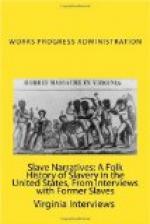Slaves were sold in two ways, sometimes at private sale to a man who went about the Southland buying slaves until he has many in his possession, then he would have a big auction sale and would re-sell them to the highest bidder, much in the same manner as our live-stock are sold now in auction sales. Professional slave buyers in those days were called “nigger buyers”. He came to the plantation with a doctor. He would point out two or three slaves which looked good to him and which could be spared by the owner, and would have the doctor examine the slave’s heart. If the doctor pronounced the slave as sound, then the nigger buyer would make an offer to the owner and if the amount was satisfactory, the slave was sold. Some large plantation owners, having a large number of slaves, would hold a public auction and dispose of some of them, then he would attend another sale and buy new slaves, this was done sometimes to get better slaves and sometimes to make money on the sale of them.
Many times, as I have said before, our treatment on our plantation was horrible. When I was just a small boy, I witnessed my sister sold and taken away. One day one of horses came into the barn and Mastah noticed that she was caripped. He flew into a rage and thought I had hurt the horse, either that, or that I knew who did it. I told him that I did not do it and he demanded that I tell him who did it, if I didn’t. I did not know and when I told him so, he secured a whip tied me to a post and whipped me until I was covered with blood. I begged him, “Mastah, Mastah, please don’t whip me, I do not know who did it.” He then took out his pocket knife and I would have been killed if Missus (his dear wife) had not make him quit. She untied me and cared for me.
Many has been the time, I have seen my mammy beaten mercilessly and for no good reason. One day, not long before the out-break of the Civil War, a nigger buyer came and I witnessed my dear Mammy and my one year old baby brother, sold. I seen er taken away, never to see her again until I found her twenty-seven years later at Clarksburg, Tennessee. My baby brother was with her, but I did not know him until Mammy told me who he was, he had grown into a large man. That was a happy meeting. After those experiences of “sixteen long years in hell, as a slave”, I was very bitter against the white man, until after I ran away and joined the Union army.
At the out-break of the Civil War and when the Northern army was marching into the Southland, hundreds of male slaves were shot down by the Rebels, rather than see them join with the Yankees. One day when I learned that the Northern troops were very close to our plantation, I ran away and hid in a culvert, but was found and I would have been shot had the Yankee troops not scattered them and that saved me. I joined that Union army and served one year, eight months and twenty-two days, and fought with them in the battle of Fort Wagnor, and also in the battle of Milikin’s Bend. When I went into the army, I could not read or write. The white soldiers took an interest in me and taught me to write and read, and when the war was over I could write a very good letter. I taught what little I knew to colored children after the War.




